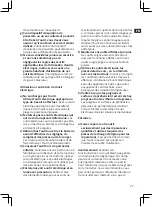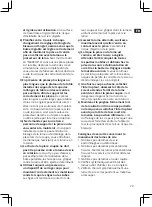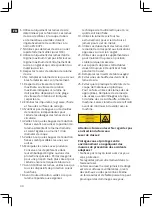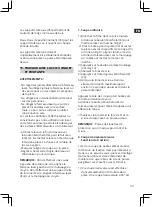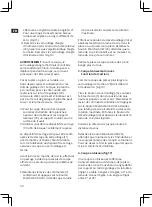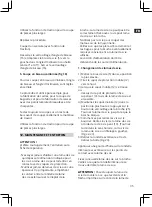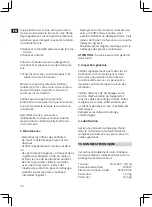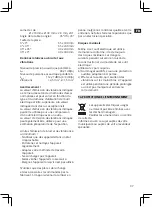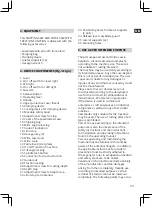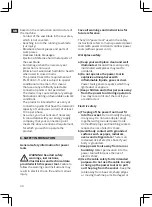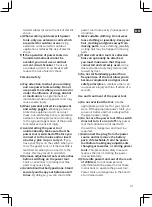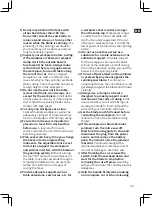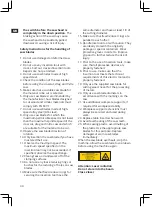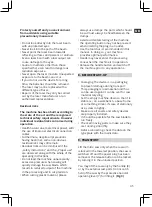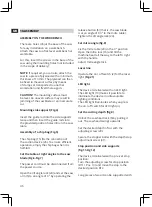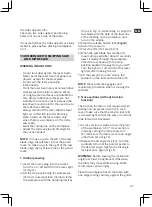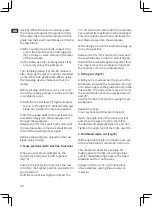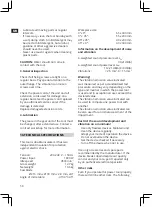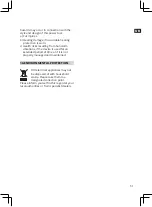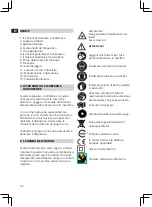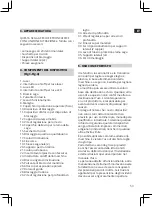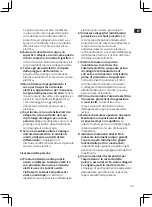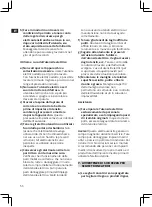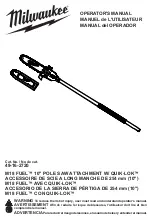
41
twisted cables increase the risk of electric
shock.
e) When working outdoors with power
tools, only use extension cords which
are suited for outdoor areas.
Using
extension cords suited for outdoor
applications reduces the risk of electric
shock.
f) lf the operation of power tools in a
humid environment cannot be
avoided, you must use a residual
current circuit breaker.
The use of
a residual current circuit breaker will
reduce the risk of electric shock.
Personal safety
a) Pay attention to what you are doing
and use power tools sensibly.
Do not
use power tools when you are tired or
under the influence of drugs, alcohol
or medication.
A single moment of
inattention while using power tools may
cause severe injury.
b) Wear personal protective equipment
and safety goggles.
Wearing personal
protective equipment such as a dust
mask, non-skid safety boots, a protective
helmet or hearing protection according
to the type and application of the power
tool reduces the risk of injury.
c) Avoid starting the power tool
unintentionally. Make sure that the
power tool is switched off before you
connect it to the mains and/or insert
a battery, pick it up or carry it.
lf you
have your finger on the switch when you
carry the power tool, or if the machine is
switched on when you connect it to the
mains, this may result in accidents.
d) Remove adjustment tools or wrenches
before switching on the power tool.
Tools or wrenches in rotating machine
parts may cause injury.
e) Avoid abnormal body positions. Stand
securely and keep your balance at all
times.
By doing so, you can control the
power tool more easily in unexpected
situations.
f) Wear suitable clothing. Do not wear
loose clothing or jewellery. Keep your
hair, clothing and gloves away from
moving parts.
Loose clothing, jewellery
or long hair may be trapped in moving
parts.
g) lf dust extraction tools or collection
bins can optionally be attached,
you must make sure that they are
connected and correctly used.
Using
dust extraction tools may reduce risks
caused by dust.
h) Do not let familiarity gained from
frequent use of the tool allow you to
become complacent and ignore tool
safety principles.
A careless action can
cause severe injury within a fraction of a
second.
Use and treatment of the power tool
a) Do not overload the tool.
Use the
appropriate power tool for your type of
work. With appropriate power tools, you
can work better and more safely within
the given power range.
b) Do not use the power tool if the switch
does not turn it on and off.
Any power
tool that cannot be controlled with
the switch is dangerous and must be
repaired.
c) Disconnect the plug from the power
source and/or remove the battery
pack, if detachable, from the power
tool before making any adjustments,
changing accessories, or storing power
tools.
This preventive safety measure
reduces the risk of starting the power
tool accidentally.
d) Store idle power tools out of the reach
of children.
Do not allow persons
unfamiliar with the power tool or these
instructions to operate the power tool.
Power tools are dangerous in the hands
of untrained users.
UK
Summary of Contents for 210.200.356
Page 2: ...2 7 1 5 23 14 12 31 30 22 24 19 32 11 13 16 10 27 28 29 26 15 9 35 33 18 36 21 1 ...
Page 3: ...3 7 2 4 8 6 17 2 3 4 25 34 32 35 33 ...
Page 4: ...4 15 26 18 13 18 29 29 31 30 30 16 19 20 22 21 6 5 7 9 11 6 8 10 12 ...
Page 5: ...5 27 28 1 3 10 11 13 15 17 19 14 16 18 20 ...

